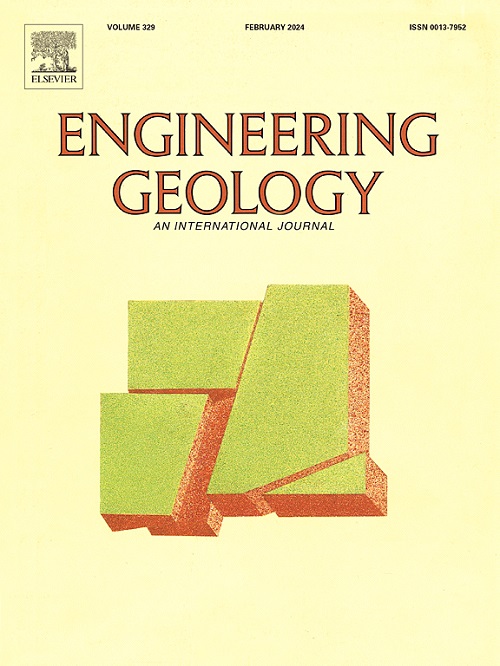Time-frequency analysis on seismic response and pre-toppling damage evolution of anti-dip rock slope under earthquake sequences by shaking table tests
IF 8.4
1区 工程技术
Q1 ENGINEERING, GEOLOGICAL
引用次数: 0
Abstract
Anti-dip rock slopes in tectonically active regions are highly susceptible to seismic loading. While their response to individual mainshocks has been widely studied, the cumulative effect of sequential earthquakes, particularly in relation to gradual, subvisible damage preceding visible toppling, remains underexplored. This study employs a large-scale shaking table test to investigate both internal and external seismic responses and the damage progression of a generalized anti-dip slope model in the time and frequency domains. Results indicate that slope acceleration initially exhibits a linear amplification pattern but transitions to nonlinear behaviour as seismic intensity increases, with the free-face effect diminishing at higher intensities. Dominant frequency nonlinearly shifts and seismic energy variations correlate with both slope height and increasing seismic loads, while a decrease in natural frequency and an increase in damping ratio revealed by transfer function analysis, typically representative of internal damage accumulation. Notably, the major damage of the rock slope model occurs during the mainshock sequence, with subsequent aftershocks exerting limited further impact. Under sequentially increasing seismic loading, slope surface deformation initiates with bulging at the toe, intensifies toward the crest, and is accompanied by uneven settlement at the top. Internal strain readings further reveal progressive bending of rock strata in response to increasing seismic input, characteristic of pre-toppling deformation. These findings provide critical insights for early warning and risk evaluation of anti-dip rock slope stability, by offering a basis for identifying pre-toppling characteristics prior to a complex and visible toppling failure.
地震序列下抗倾岩质边坡地震反应及预倾损伤演化的时频分析
构造活动区的反倾岩质边坡极易受到地震荷载的影响。虽然它们对单个主震的反应已被广泛研究,但连续地震的累积效应,特别是与可见倒塌之前逐渐的、不可见的破坏有关的效应,仍未得到充分研究。本文采用大尺度振动台试验,研究了广义抗倾边坡模型的内外地震反应和损伤进展。结果表明,边坡加速度最初表现为线性放大模式,但随着地震烈度的增加而转变为非线性行为,在高烈度时自由面效应逐渐减弱。主导频率非线性位移和地震能量变化与边坡高度和地震荷载的增加有关,而传递函数分析显示固有频率的降低和阻尼比的增加,典型地代表了内部损伤的累积。值得注意的是,岩质边坡模型的主要破坏发生在主震序列期间,后续余震的进一步影响有限。在地震荷载依次增大的情况下,坡面变形以坡脚隆起开始,向坡顶加剧,并伴有顶部不均匀沉降。内部应变读数进一步揭示了随着地震输入的增加,岩层的逐渐弯曲,这是倾倒前变形的特征。这些发现为反倾岩质边坡稳定性的早期预警和风险评估提供了重要见解,为在复杂和可见的倾倒破坏之前识别预倾倒特征提供了基础。
本文章由计算机程序翻译,如有差异,请以英文原文为准。
求助全文
约1分钟内获得全文
求助全文
来源期刊

Engineering Geology
地学-地球科学综合
CiteScore
13.70
自引率
12.20%
发文量
327
审稿时长
5.6 months
期刊介绍:
Engineering Geology, an international interdisciplinary journal, serves as a bridge between earth sciences and engineering, focusing on geological and geotechnical engineering. It welcomes studies with relevance to engineering, environmental concerns, and safety, catering to engineering geologists with backgrounds in geology or civil/mining engineering. Topics include applied geomorphology, structural geology, geophysics, geochemistry, environmental geology, hydrogeology, land use planning, natural hazards, remote sensing, soil and rock mechanics, and applied geotechnical engineering. The journal provides a platform for research at the intersection of geology and engineering disciplines.
 求助内容:
求助内容: 应助结果提醒方式:
应助结果提醒方式:


